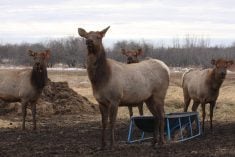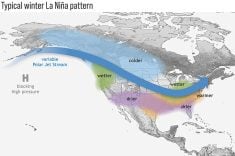A company that says it has saved growers $120 million annually by introducing cheaper products into the glyphosate market is promising to do it again with other pesticides.
“We have a fairly lengthy list of products that we think can bring increased competition to the marketplace,” said Darren Palendat, Farmers of North America’s crop protection manager.
The company has four active ingredients registered with the Pest Management Regulatory Agency, one of which has received end-use registration, and another six in earlier stages of the process. Some of the products should be available to growers within weeks or months. Others are a few years away from the marketplace.
Read Also

Saskatchewan throne speech promises strong economy
Saskatchewan’s legislative agenda for the coming year will focus on meeting the challenges of new world trading relationships, said the speech from the throne.
The company has a wild oat and wild millet product for cereals, a grassy weed herbicide for pulses and oilseeds, a broadleaf product for cereals, pulses and oilseeds and a variety of fungicides and insecticides.
Their commercial introduction awaits the passage of the federal government’s proposed new generic pesticide registration regulations, which have been published and are now open for comment.
Palendat said the proposed regulations could ease the registration process but he worries they could become “a monster.”
“There are other manufacturers who have products registered that would like nothing better than to see us shut out of the marketplace because we force competition,” he said.
Peter MacLeod, vice-president of chemistry with CropLife Canada, an association that represents both brand name and generic manufacturers, said the proposed regulation is fair.
The comment period expires Jan. 28, with CropLife expected to suggest small changes to the proposal.
“We anticipate that if all goes well, this regulation could be in force as early as May,” said MacLeod. He noted that even under the existing system, 34 generic technical active ingredients have been approved in the last two years.
Palendat said at least one, or perhaps more, of the company’s new offerings will be commercially available by spring.
He said the new crop protection products should create a situation similar to what happened with ClearOut 41 Plus, the generic gly-phosate product that FNA brought into Canada under the previous import regulations.
Palendat said ClearOut drove down glyphosate prices by about $3 per litre. The Canadian market for gly-phosate is a minimum of 40 million litres per year, which means the chemical saved farmers about $120 million annually. He believes the cost savings associated with the company’s new wild oat control for cereal crops will top that amount.
Palendat estimated the chemical will drive down wild oat control costs on 30 million acres of cereal crops by $5 per acre for a total annual savings of $150 million.
Saskatchewan Agriculture weed specialist Clark Brenzil said there has already been a significant increase in competition from generics and private label products in the wild oat market, so it would be difficult to gauge the economic impact of the FNA product.
“That wild oat/green foxtail marketplace just exploded with new entries last year,” he said.















